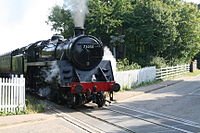Halsuntrian Railways Service: Difference between revisions
Halsuntria (talk | contribs) No edit summary |
Halsuntria (talk | contribs) No edit summary |
||
| Line 1: | Line 1: | ||
The Halsuntrian Railway Service (HRS) is the general term for all railways in Halsuntria, regardless of size. The HRS is the most used mode of interstate transportation in Halsuntria with about 20,000 more passengers than highways each year. The HRS has about 25,000 miles of rail in Halsuntria which can be divided into standard (1372 mm), small (762 mm), and wide (1668 mm) gauges. The standard gauge is the most used in Halsuntria as it makes up most of the rails that goes in and out of cities, the next is small which is the large majority of regional routes and overall smaller lines mostly throughout the countryside, it is noted that about 1/3 of these are heritage railways with the sole purpose for tourism. The least used is wide gauge which has a variety of uses and it is mainly for odd jobs such as at a harbor or other industrial facility. | The Halsuntrian Railway Service (HRS) is the general term for all railways in Halsuntria, regardless of size. The HRS is the most used mode of interstate transportation in Halsuntria with about 20,000 more passengers than highways each year. The HRS has about 25,000 miles of rail in Halsuntria which can be divided into standard (1372 mm), small (762 mm), and wide (1668 mm) gauges. The standard gauge is the most used in Halsuntria as it makes up most of the rails that goes in and out of cities, the next is small which is the large majority of regional routes and overall smaller lines mostly throughout the countryside, it is noted that about 1/3 of these are heritage railways with the sole purpose for tourism. The least used is wide gauge which has a variety of uses and it is mainly for odd jobs such as at a harbor or other industrial facility. | ||
[[File:Steam engine train.jpg|200px|thumb|right| One of the hundreds of steam trains still active in Halsuntria.]] | |||
Steam and electric trains are used almost equally when it comes to passenger transport while freight trains are almost exclusively diesel. Despite steam trains being generally slower than electric, they are loved by tourists as well as Halsuntrian citizens as it is unique and has almost became a part of Halsuntrian culture to have steam trains. Trains in general have became a huge part of Halsuntria's history with them being the main mode of transportation and that is due to them having a rich history in Halsuntria dating all the way back to the 1690's. | |||
==History== | ==History== | ||
Revision as of 19:50, 7 February 2021
The Halsuntrian Railway Service (HRS) is the general term for all railways in Halsuntria, regardless of size. The HRS is the most used mode of interstate transportation in Halsuntria with about 20,000 more passengers than highways each year. The HRS has about 25,000 miles of rail in Halsuntria which can be divided into standard (1372 mm), small (762 mm), and wide (1668 mm) gauges. The standard gauge is the most used in Halsuntria as it makes up most of the rails that goes in and out of cities, the next is small which is the large majority of regional routes and overall smaller lines mostly throughout the countryside, it is noted that about 1/3 of these are heritage railways with the sole purpose for tourism. The least used is wide gauge which has a variety of uses and it is mainly for odd jobs such as at a harbor or other industrial facility.
Steam and electric trains are used almost equally when it comes to passenger transport while freight trains are almost exclusively diesel. Despite steam trains being generally slower than electric, they are loved by tourists as well as Halsuntrian citizens as it is unique and has almost became a part of Halsuntrian culture to have steam trains. Trains in general have became a huge part of Halsuntria's history with them being the main mode of transportation and that is due to them having a rich history in Halsuntria dating all the way back to the 1690's.
